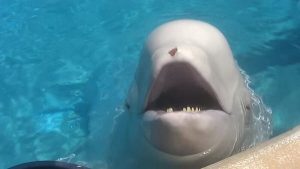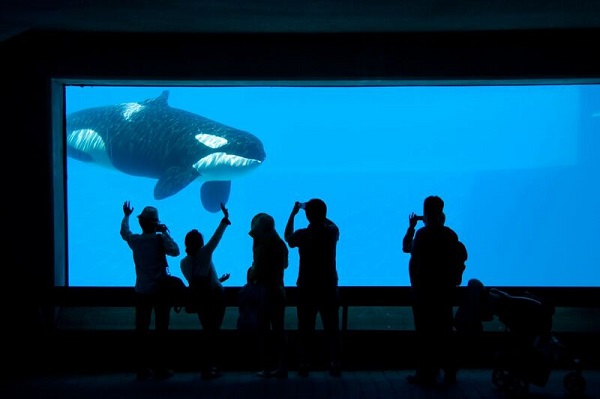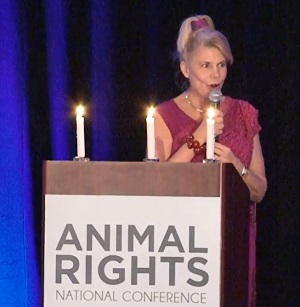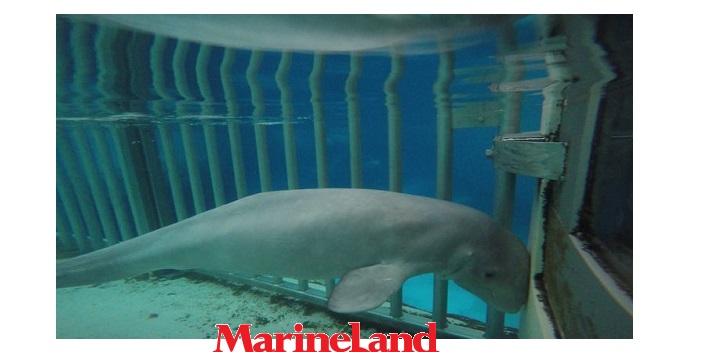International animal protection organization, In Defense of Animals, today released its list of the Ten Worst Tanks for Dolphins and Whales in North America, with Ontario’s Marineland shamed as the worst aquarium in Canada, and second overall.
The facility is listed as having the ‘starkest contrast’ between a ‘solitary orca and beluga whale hoarding’ while Canada’s Vancouver Aquarium appears in ninth place. The Ten Worst Tanks list exposes and represents the misery and suffering of the oceans’ most intelligent and complex mammals in captivity. Whales and dolphins are subject to astonishing rates of premature death, captivity-related injuries, forced removal of babies from mothers, and solitary isolation. Many are confined to swimming endless circles in cramped tanks, deprived of healthy social groups, and forced to endure invasive reproduction techniques, polluted water, dangerous transport, and brutal exploitation of their sociable natures through “swim” and “petting” programs.

 The list was selected from over 60 facilities from southern Canada to Mexico where almost 1,000 whales and dolphins are held captive for public display. “Forcing an orca to live in solitary confinement while hoarding so many beluga whales is Marineland’s tragic dichotomy, and a horrific example of cetacean captivity. It plumbs the depths in its exploitation of intelligent and sensitive animals,” said In Defense of Animals President, Dr. Marilyn Kroplick. “Even with the most modern technology, veterinary care, and infrastructure, cetaceans still suffer intensely in captivity and exhibit surprisingly high mortality rates.Please help protect dolphins and whales in the wild where they belong, by pledging to never visit facilities that imprison them.”
The list was selected from over 60 facilities from southern Canada to Mexico where almost 1,000 whales and dolphins are held captive for public display. “Forcing an orca to live in solitary confinement while hoarding so many beluga whales is Marineland’s tragic dichotomy, and a horrific example of cetacean captivity. It plumbs the depths in its exploitation of intelligent and sensitive animals,” said In Defense of Animals President, Dr. Marilyn Kroplick. “Even with the most modern technology, veterinary care, and infrastructure, cetaceans still suffer intensely in captivity and exhibit surprisingly high mortality rates.Please help protect dolphins and whales in the wild where they belong, by pledging to never visit facilities that imprison them.”

Marineland’s Shame: Marineland holds Canada’s last captive orca, 40 or so year-old Kiska, who was ripped away from her family and native Icelandic waters when she was a baby. Kiska has outlived at least seventeen other orcas with whom she has shared the tank over the years. She has also been used to breed for new exhibits, enduring the death of every last one of her five children at Marineland, none of whom lived longer than six years. One of them, Kanuck, was apparently separated from her prematurely and “stored” in a warehouse, where he died at age four. Since 2011, Kiska has been kept in solitary confinement, which has no doubt caused great suffering for this highly social and intelligent cetacean. The last orca Kiska knew was a male named Ikaika, who was “loaned” to Marineland by SeaWorld for breeding in 2006.
SeaWorld became “concerned about Ikaika’s physical and psychological health” and stated that Marineland was “not meeting its obligations in veterinary care, husbandry, or training.” Citing these concerns, SeaWorld successfully sued Marineland in 2011 for Ikaika’s return, leaving Kiska alone once more. Kiska’s physical and psychological condition appears to be poor. Observers point to her severely worn down teeth from self-injurious and compulsive gnawing, dorsal fin deterioration, signs of being underweight, and intermittent bleeding from her tail as indicators of greatly compromised health. Behaviorally, Kiska exhibits lethargy, self-isolation in a tiny medical pool adjacent to the main pool, and repetitive stereotyped behaviors; strong indications of severe psychological distress, depression, and despondency. Kiska is not the only animal suffering at Marineland.
CEO John Holer has also amassed approximately 46 beluga whales, five bottlenose dolphins, 28 black bears and approximately 500 fallow deer. An undercover investigation by Last Chance for Animals in 2015 reportedly exposed belugas suffering from a litany of physical ailments, including eye abnormalities, hypersalivation, regurgitation, and a condition in some of the females causing them to rub chronically against the tank until blood was visible in the water. Lacerations and deep teeth-rake marks indicating inescapable stress-related aggression from other belugas were also noted on many of the belugas. We are also concerned about signs of severe eye irritation perhaps caused by chemically-treated water.
Later in 2015, the Ontario Society for the Prevention of Cruelty to Animals (OSPCA) made a non-public finding that questioned some of Last Chance for Animals’ claims of abuses at Marineland. But Julie Woodyer of Zoocheck has filed a new complaint with the Ontario Society for the Prevention of Cruelty to Animals documenting continued violations of the Captive Animal Care Standards at Marineland.

We urge the Ontario Society for the Prevention of Cruelty to Animals to act urgently to enforce minimum standards at Marineland. Belugas have certainly not evolved for millions of years to be packed into a tank – and orcas are among the most social and family-oriented species on the planet.
10 WORST TANKS: 1. SeaWorld, San Antonio, Texas; San Diego, California; Orlando, Florida 2. Marineland, Niagara Falls, Ontario, Canada 3. Puerto Aventuras Dolphin Discovery, Mayan Riviera, Quinta Roo, Mexico 4. Georgia Aquarium, Atlanta, Georgia 5. Miami Seaquarium, Miami, Florida 6. Six Flags Mexico, Mexico City, Mexico 7. Institute for Marine Mammal Studies, Gulfport, Mississippi and Unnamed new facility planned by same owner also in Gulfport, Mississippi 8. Mirage Hotel, Las Vegas, Nevada 9. Vancouver Aquarium, Vancouver, British Columbia, Canada 10. Shedd Aquarium, Chicago, Illinois
Dishonorable Mention: Dophinaris, Scottsdale, Arizona
Honorable Mention: National Aquarium, Baltimore, Maryland
The Ten Worst Tanks list was produced over the past year by multiple cetacean experts and scientists to represent the myriad horrors faced by cetaceans in captivity. Facilities were examined and investigated in-person; through review of government records, veterinary records, and death reports; and via image and data documentation. For more information please visit: www.idausa.org/10WorstTanks
In Defense of Animals is an international animal protection organization located in San Rafael, Calif. dedicated to protecting animals’ rights, welfare, and habitats through education, outreach, and our hands-on rescue facilities in India, Africa, and rural Mississippi. For the Silo, Toni Frohoff, Ph.D.



